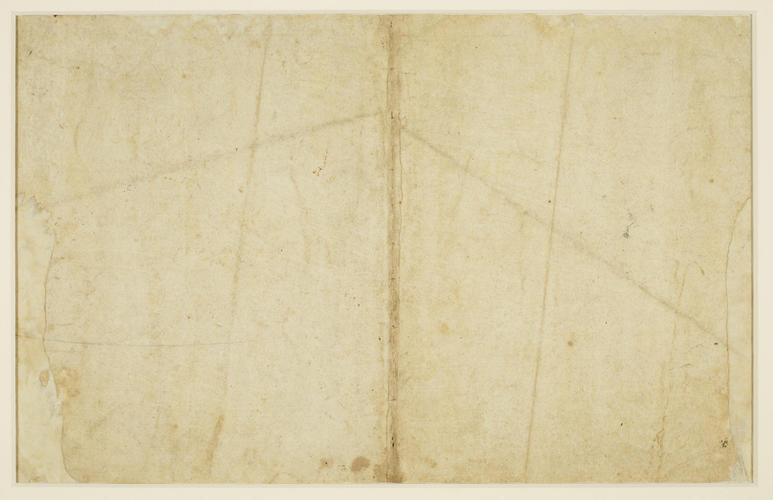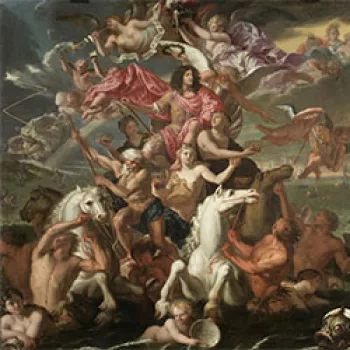St Mark and St John with putti c.1525
Red chalk over squaring with a stylus. Watermark of an anchor in a circle with a star. | 32.7 x 51.2 cm (sheet of paper) | RCIN 991218
-
This magnificent sheet is a study for a fresco in the Cappella del Crocifisso of the church of San Marcello, on the Corso in Rome. In May 1519 the old church of San Marcello was destroyed by fire, but among the ruins was found an intact wooden crucifix, which was thus held to have miraculous properties and was carried in procession during the plague of 1522. The abatement of the plague led Cardinal Guglielmo Raimondi di Vich to found the Confraternità del Santissimo Crocifisso (‘Confraternity of the Most Holy Crucifix’), one of the most important confraternities to flourish in Rome in the sixteenth century, and whose first artistic initiative was the decoration of the chapel erected to house the miraculous crucifix as part of the rebuilding of San Marcello.
On 6 February 1525 Perino signed a contract with the confraternity to execute frescoes in the chapel, to be completed by 20 March 1526. At the Sack of Rome in 1527 the work was unfinished, and was not resumed until Perino returned from Genoa and Pisa a decade later. A revised contract was signed with Perino on 25 April 1539, now stipulating completion by May 1540, though it is not until May 1543 that we have a record of the chapel in a completed state. (For the documents see G. Fiocco, ‘La Cappella del Crocifisso in San Marcello’, Bollettino d’Arte, 1913, pp. 87-94.)
Perino's frescoes are confined to the barrel vault of the chapel and feature monumental figures of the Evangelists seated in two pairs, either side of a Creation of Eve. St Augustine had seen in the creation of Eve, from the rib taken from Adam's side, a prefiguration of the blood and water that issued from Christ's wound on the Cross, and thus of the two principal Christian sacraments, Eucharist and Baptism. Giorgio Vasari stated that in the first campaign Perino had painted the Creation of Eve and most of the two Evangelists studied here, and that the head and right arm of St John and all of Sts Matthew and Luke were executed by Daniele da Volterra to Perino's designs after 1539 (Vite de Pittori..., 1568, II, pp. 359f; III, p. 677). This division of hands was confirmed by restoration work around 1960.
The present drawing is close in its details to the painting as executed, and probably served as the model for the full-scale cartoon. The only significant change was to correct the position of St John: here Perino has drawn over a squared grid incised with the stylus (most clearly seen at far left), presumably to transfer the figures from another, sketchier sheet – but he began St John in the wrong square, and he therefore sits one square lower than he should do. The earlier sheet may have been the damaged study for the whole ceiling in Berlin (Kupferstichkabinett, KdZ 22004), which shows God the Father in the central field, indicating a late change in the iconographic programme, as the figures of Sts Mark and John are essentially identical to those here. The figures of Sts Matthew and Luke as painted are however radically different from those in the Berlin study, and were presumably redesigned when the second campaign on the vault began in the late 1530s.
Three sheets of single-figure studies connected with the ceiling survive. A drawing in the Albertina of St Mark with the lion and the left-hand putto is probably a workshop copy after a drawing by Perino (Birke & Kertész 437; a weak copy after what was probably the same original was at Christie's, 1 April 1987, lot 102). Two drawings of St Matthew and St Luke in the Louvre are in the smooth, closely hatched chalk style typical of Daniele, who presumably worked them up from preliminary drawings by Perino; the Louvre also holds a study by Daniele for the left arm of St Matthew (inv. 1495). In Munich (inv. 21222) is a probable copy of a lost drawing by Perino for the group of Sts Matthew and Luke.
The drawing was in the Roman collection of Antonio Tronsarelli, posthumously inventoried in 1601, where it is listed as 'Un S. Giovanni e un San Marco con doi puttini in foglio di carta Reale de lapis rosso de mano de Pierino messi in opra da essa in S. Marcello alla cappella del Crucifisso' (M. Lafranconi, Burlington Magazine, 1998, pp. 537-50). Within fifty years the drawing was in England, for it bears a six-pointed star stamp of a type closely resembling the five- and eight-pointed stars traditionally connected with Nicholas Lanier, one of Charles I's principal agents for the purchase of works of art. The drawing also bears on the verso an early reinforcing strip along the central fold with the inscription Jerom; another drawing at Windsor, by Alessandro Allori (RCIN 906018), bears the same star mark on the recto and the same inscription on the verso, and several other sheets bear either the inscription or the star mark. These probably indicate the ownership of Jerome Lanier (d.1657), Nicholas's uncle and also an amateur of art, who had travelled with Inigo Jones and Thomas Howard, Earl of Arundel, in Italy in 1613. The subsequent path of the drawing into the Royal Collection is unknown, but it was probably acquired later that century by Charles II.Provenance
In the collection of Antonio Tronsarelli, Rome (d.1601); probably Jerome Lanier (?his six-pointed star stamp, not in Lugt); probably acquired by Charles II; possibly recorded in a list of albums of drawings at Kensington Palace, 1727. Recorded in George III's 'Inventory A', c.1810, p. 52, Guilio [sic] Romano, Polidoro, e Perino del Vaga, Tom. 2, '11. St Mark & St John...[Perin del Vaga]'
-
Creator(s)
Acquirer(s)
-
Medium and techniques
Red chalk over squaring with a stylus. Watermark of an anchor in a circle with a star.
Measurements
32.7 x 51.2 cm (sheet of paper)
Object type(s)












